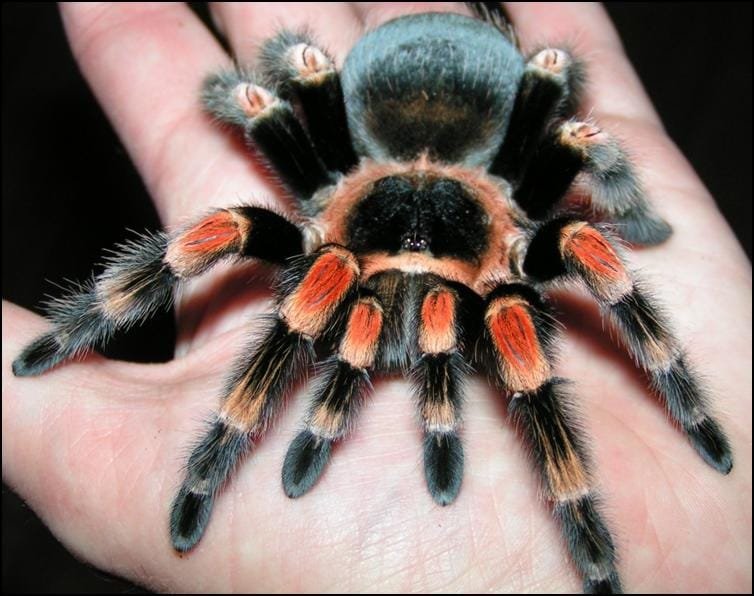
Let’s dive into this topic together, like we’re sitting in a cozy coffee shop, discussing your new fascination with tarantulas. You might be wondering if getting a Mexican redknee as a pet is a smart move, or if you should steer clear because of their bite. So, let’s clear up the myths and get to the facts.
Understanding the Mexican Redknee Tarantula
The Mexican redknee, scientifically known as *Brachypelma smithi*, is a terrestrial tarantula commonly found in Mexico. They’re famous for their striking appearance, with vibrant red-orange markings on their knees and a generally fuzzy, dark body. These tarantulas can grow to about 4 to 6 inches in length, making them one of the larger species, but they’re also known for being relatively docile.
Here’s the thing: while they may look intimidating, their temperament is usually quite gentle. Many enthusiasts choose them as pets because they’re easier to handle compared to other tarantula species. However, like with any creature, it’s important to know what you’re getting into—especially regarding their defense mechanisms.
Do Mexican Redknee Tarantulas Bite?
Yes, the Mexican redknee can bite, but it’s not as common as you might think. These spiders usually prefer to flee or show off their threat displays before resorting to biting. If you ever see a tarantula raising its front legs and showing off its fangs, that’s its way of saying, “Back off!” Most of the time, they’d rather avoid a confrontation altogether.
If a bite does happen, it’s often due to improper handling or if the spider feels cornered. Remember, these creatures don’t generally want to harm you; they just want to be left alone in their habitat.
What Happens if You Get Bitten?
If you’re unfortunate enough to experience a bite from a Mexican redknee, the good news is that it’s usually not serious. Their venom is relatively mild compared to many other spiders. Here’s what you might experience:
- Minor Pain: You might feel a slight sting, similar to a bee sting.
- Redness and Swelling: The area around the bite may become red and swollen, but this usually goes down quickly.
- Itching: Some people report an itching sensation after being bitten.
In most cases, treatment isn’t required, but it’s always a good idea to clean the area and monitor for any signs of infection if you’re bitten. If you have a severe allergic reaction or other ongoing issues, seek medical attention promptly.
The Importance of Proper Handling
If you’re considering getting a Mexican redknee as a pet, it’s essential to learn the right way to handle and care for them. Here are some tips:
- Watch for Signs of Stress: If your tarantula is balled up or hiding, it might be best to leave it alone.
- Use a Container: When handling, place your tarantula in a secure container rather than directly in your hands.
- Educate Yourself: Learn about their behaviors and needs—this will help you build a bond with your pet.
By understanding these basic principles, you can significantly reduce the chances of being bitten and create a safer environment for both you and your pet.
Why Some People Fear Tarantulas
The fear of tarantulas, or arachnophobia, is very common and often stems from cultural perceptions. Movies and media tend to exaggerate the danger these creatures pose, showcasing them as vicious predators. In reality, most tarantulas, including the Mexican redknee, are more interested in avoiding humans than attacking.
Education plays a crucial role in demystifying these spiders. By understanding their habits and behavior, people can see that the fear is often unfounded. Think of it like getting to know a new coworker; once you learn about them, the initial fear or anxiety usually fades away.
Alternatives for New Pet Owners
If you’re still uncertain about jumping into tarantula ownership or if the idea of getting bitten makes you nervous, there are alternatives. Consider smaller or less intimidating pets, such as:
- Leopard Geckos: These reptiles are friendly and easy to care for.
- Hamsters: A classic small pet that can be quite fun to interact with.
- Fish: They require less handling and can be very calming to watch.
Choosing a pet that matches your comfort level can open up new doors to adventure without the concern of bites or scares!
Final Thoughts
So, does the Mexican redknee tarantula bite? Yes, but it’s not as scary as it seems. With proper handling and respect for their space, these fascinating creatures can be wonderful companions. If you’re curious about them but not sure you want to take the plunge into tarantula ownership, that’s perfectly okay too! Whether you decide to learn more or explore other pet options, the important thing is to approach with knowledge and respect. That way, you can enjoy all the wonders of the animal kingdom—without the bites!

